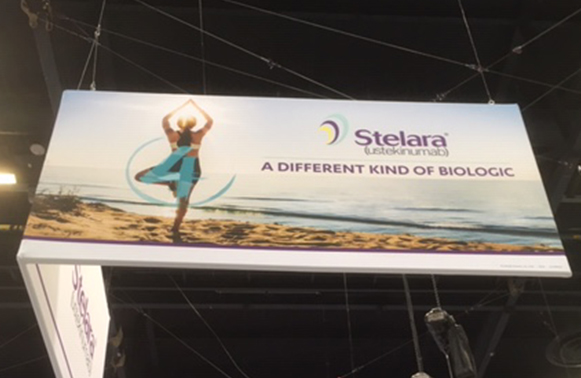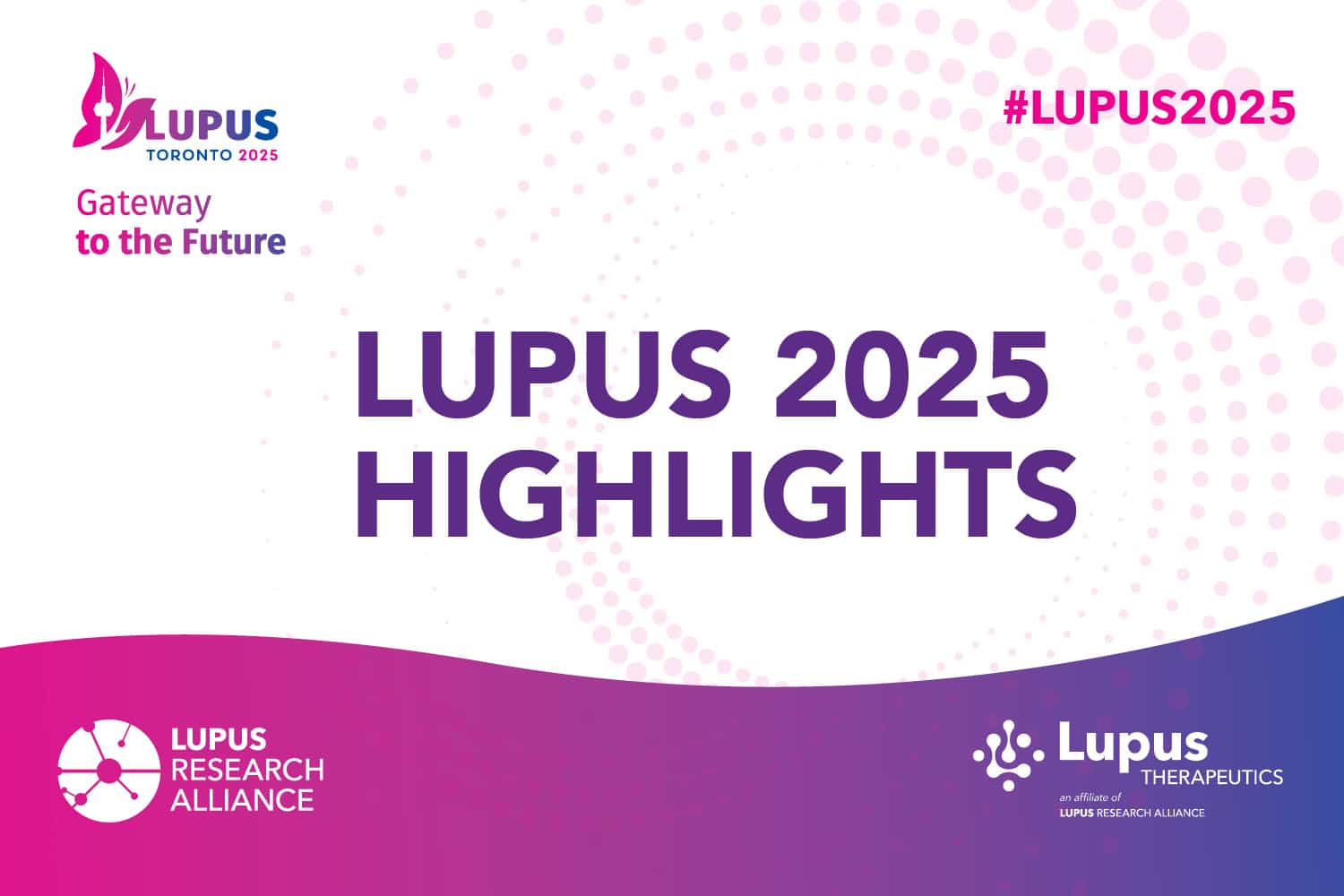ACR|ARHP News on Potential New Lupus Treatments

ACR|ARHP News on Potential New Lupus Treatments
October 25, 2018
The Lupus Research Alliance was on the ground at the American College of Rheumatology 2018 meeting to bring you the latest news in lupus research and translation. Several clinical trials showed benefits of potential new treatments for helping people with lupus. Following are summaries of the stand-out results:
Ustekinumab (Stelara®)
A Phase 2 controlled study compared the investigational monoclonal antibody ustekinumab (Stelara®) with placebo among patients with active lupus. Investigators had previously reported greater improvement with Stelara® vs placebo in several common measures of disease activity through six months. The new results presented at ACR 2018 showed similar improvements through one year. Stelara® is approved by the FDA as a treatment for psoriasis, psoriatic arthritis, and Crohn’s disease. In this lupus study, Stelara’s safety was similar as when used for these other conditions. The Phase 3 trial is underway and is being conducted through the Lupus Research Alliance Lupus Clinical Investigators Network (LuCIN) throughout North America. This study was sponsored by Janssen Research & Development, LLC. The Lupus Research Alliance is particularly excited about this study having first identified the potential of Stelara as a possible treatment for lupus and requested that Janssen test its use in people with lupus.
Baricitinib
A 24-week (wk) global, Phase 2, double-blind, placebo (PBO)-controlled study in patients with SLE receiving standard therapy showed improvement from treatment with baricitinib at a 4-mg dosage compared with placebo according to accepted measurement scales. Specific symptoms that showed significant improvement included arthritis or rash, flare, and pain. Baricitinib is approved for rheumatoid arthritis in Europe and Japan. The principal author was Dr. Daniel J. Wallace of Cedars-Sinai Medical Center/ David Geffen School of Medicine at University of California Los Angeles. The study was sponsored by Eli Lilly and Company.
Atacicept
Researchers presented additional analysis of results from the Phase 2 ADDRESS II and its long-term extension study describing low disease activity and remission rates at 48 weeks in patients with high disease activity at the start of the trial. The current study found that patients in the ADDRESS II trial who had high disease activity, prior to entering the trial, and received 150mg of the investigational drug (atacicept) were more likely to attain Low Disease Activity (LDA), Lupus Low Disease Activity State (LLDAS) and remission at week 48 than those patients treated with 75mg atacicept or placebo. Importantly, these endpoints—LDA, LLDAS and remission—were more discerning than SRI-6. This, supports LLDAS, LDA and remission as strong endpoints for lupus trials. The study also lends additional support for further studies of atacicept in SLE. Atacicept inhibits B cells by binding to a major B cell survival and growth factor. The primary author of this study was Professor Eric Morand, Monash University in Australia and a Lupus Research Alliance Distinguished Innovator Award recipient. The sponsor of the study is EMD Serono, Inc. a subsidiary of Merck KGaA.
XmAB5871
In a small Phase 2 double-blind, randomized, placebo-controlled trial of patients with moderate to severe lupus, the investigational agent XmAb5871 was well-tolerated, infection rate was low and flares were similar to other lupus trials. At 169 days, 57.7 percent of people treated with XmAB5871 showed improvement according to standard SLEDAI measurement versus 34.6 percent given placebo. At 225 days, the response rate with XmAb5871 was 40.4 percent versus 23.1 percent with placebo. Investigators concluded that preliminary data from this small trial supports further evaluation of XmAb5871 in SLE. The principal author of this study is Dr. Joan T. Merrill at Arthritis and Clinical Immunology, Oklahoma Medical Research Foundation and was sponsored by Xencor, Inc.
Bioelectronic Medicine Device
An innovative approach, using a bioelectronic medicine device, developed by the Feinstein Institute’s Center for Bioelectronic Medicine significantly reduced pain and fatigue in patients with lupus, according to Feinstein Institute for Medical Research Professor Cynthia Aranow, MD, who presented the pilot clinical trial results at ACR. The vagus nerve controls the heart, lungs and digestive tract. Stimulation of the vagus nerve in previous studies was shown to reduce inflammation. This study warrants further investigation of this intervention. It was sponsored by Northwell Health and the John and Marcia Goldman Foundation.
Anifrolumab
The phase 2b Muse trial had tested whether the investigational agent anifrolumab was safe and reduced the severity of lupus symptoms. The researchers analyzed new data from the trial to determine whether anifrolumab is beneficial for cardiovascular disease, the leading killer of patients with lupus. Treatment with anifrolumab decreased the amount of DNA released by some immune cells that can damage the blood vessels and increase the risk of atherosclerosis. In addition, anifrolumab significantly improved the body’s ability to transport excess cholesterol away from tissues throughout the body, thereby decreasing accumulation and blockage in the blood vessels. The study was conducted through a collaboration among MedImmune; the National Institute of Arthritis and Musculoskeletal and Skin Diseases; National Heart, Lung, and Blood Institute; and AstraZeneca.
Leflunomide
A comparative open-label trial conducted in China compared maintenance therapy for lupus nephritis with azathioprine vs. leflunomide, an immunosuppressant commonly used in treating rheumatoid arthritis. Results showed that leflunomide is comparable to azathioprine in effectiveness and safety. There was a trend towards lower rate of relapse and a higher rate of complete response among those treated with leflunomide as maintenance therapy for two years. Conducted at many sites throughout China, the study was sponsored by RenJi Hospital.
Low-Dose IL-2 and Rapamycin
A study in China of refractory patients (those who have not responded well enough to current treatments) showed a benefit from treatment with low-dose Interleukin-2 combined with rapamycin. After 24 weeks, 26 percent of these refractory patients achieved remission meaning that with treatment, their disease was not active. The need for treatment with glucocorticoids and immunosuppressants was also reduced. In addition, there was an increase in the number of T cells called Tregs that help regulate and modulate the immune system.
Abatacept (Orencia®)
Results of a 24-month, randomized, Phase 3, multicenter, double-blind study, in lupus patients with active proliferative nephritis, showed the investigational abatacept did not reach the primary goal of complete response to treatment (defined as a significant number of patients achieving improvement in several measurements of kidney disease). However, patients treated with abatacept did show rapid improvement in the levels of protein in the urine from three months after starting treatment with abatacept and continued improvement over three years. Sponsored by Bristol-Myers Squibb, this multicenter trial was conducted throughout the world. Orencia® is approved to treat moderate to severe rheumatoid arthritis.
Belimumab
A poster authored by Maria Dall’Era at University of California, San Francisco reported results of the CALIBRATE study which aimed to see if adding belimumab to treatment with rituximab would benefit patients with lupus or lupus nephritis. There was no difference in kidney response after 48 weeks among patients treated with rituximab plus belimumab compared with those who received rituximab alone. Investigators expect further analyses at 96 weeks will provide information on the potential benefits of this combined regimen. This study was sponsored by the National Institute of Allergy and Infectious Diseases and was conducted by the Immune Tolerance Network.
Lulizumab
In a 24-week randomized, multicenter, double-blind Phase 2 study of patients diagnosed with lupus, the investigational drug lulizumab did not show significant improvement compared with placebo in the primary measure of efficacy – proportion of responders to the British Isles Lupus Assessment Group (BILAG)-based Composite Lupus Assessment (BICLA). Other measures of efficacy also did not show significant improvement. Investigators noted that lulizumab was shown to have a favorable safety profile, meaning a relatively low risk for serious side effects.
“Many presentations at this year’s ACR meeting demonstrated the very real progress that is being made in bringing new treatments to people with lupus,” noted Kenneth M. Farber, Lupus Research Alliance President and CEO. “It is tremendously exciting and gratifying to see positive results from many potential new treatments that our funded researchers identified as targets for development. And we are gaining valuable insights about the disease from the data produced by all the trials.”



